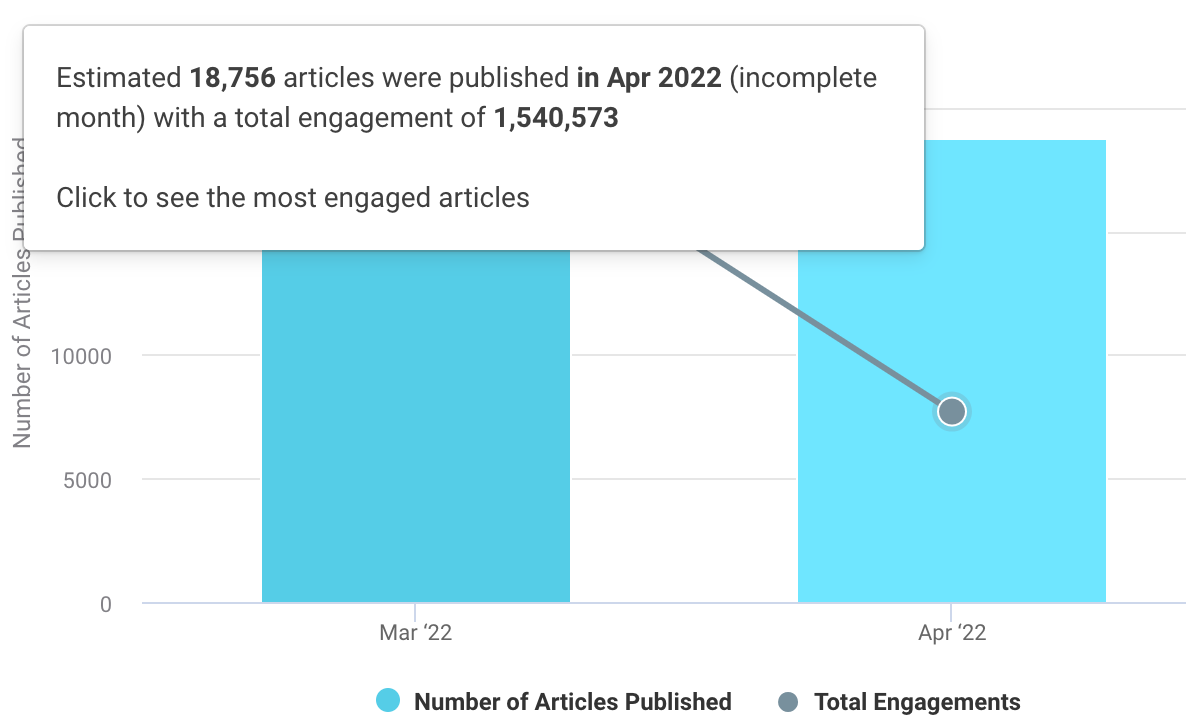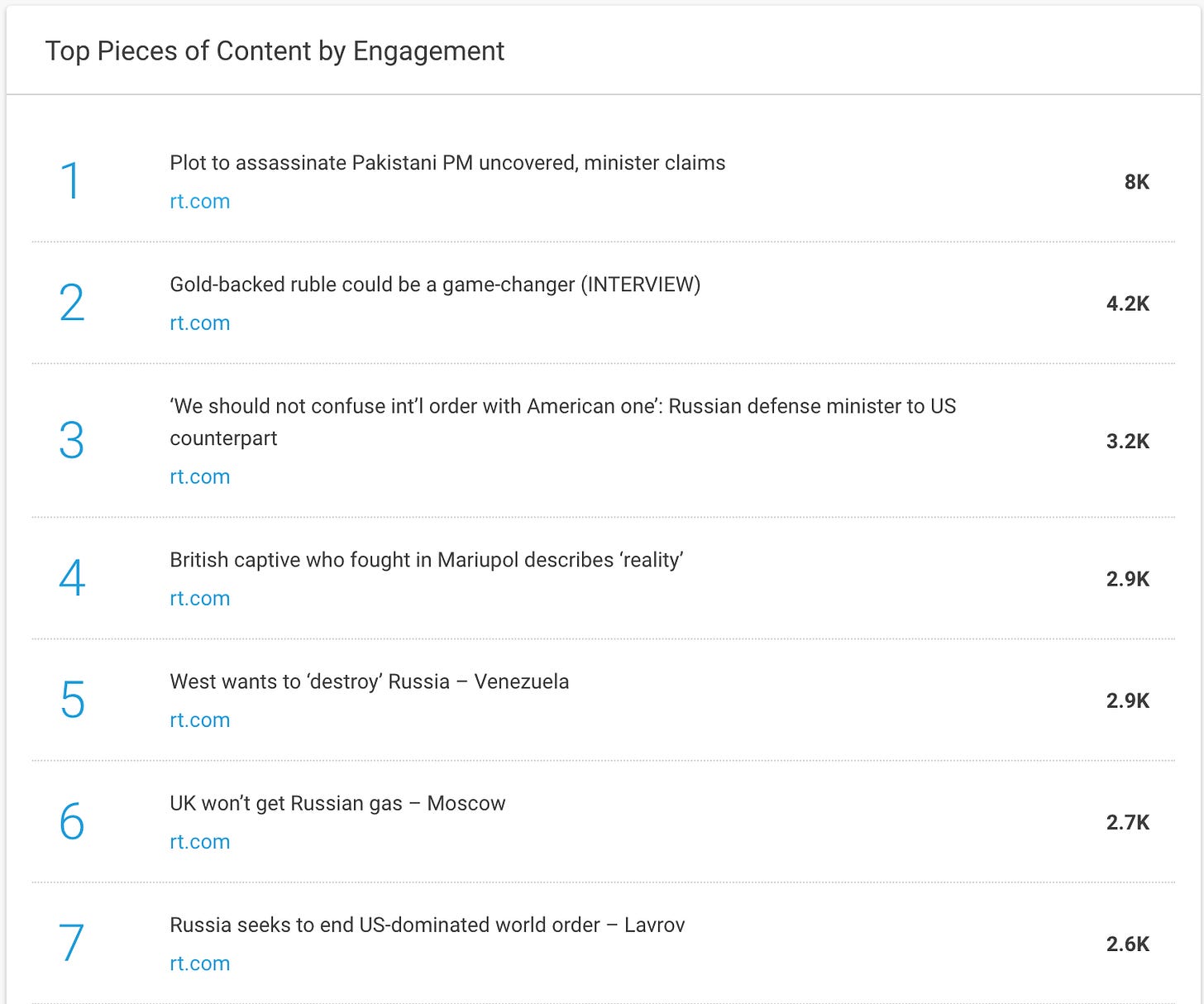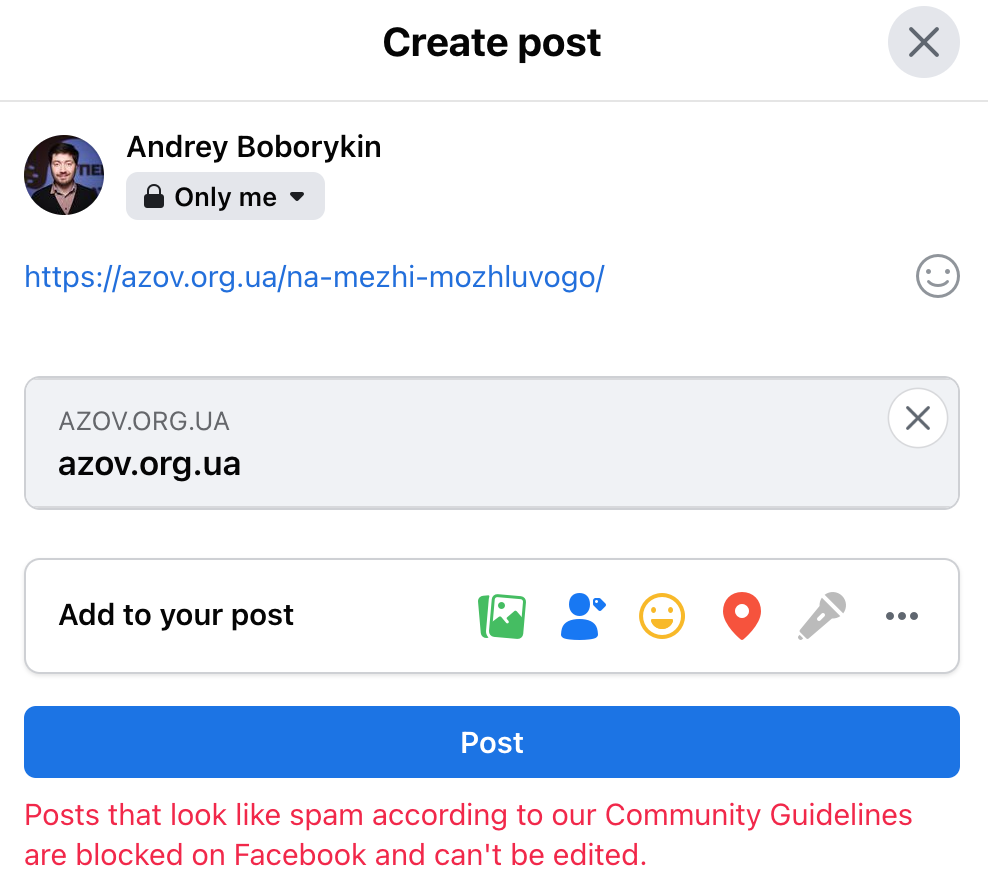So, how’s RT and Sputnik doing?
Banned, but surprisingly still getting a ton of engagement
It’s mid-May and I couldn’t wait to do a follow up to the previous post and check in on two biggest Russian propaganda websites - RT and Sputnik - two months into being shadow-banned on major tech platforms.
I still cannot figure out why these two websites weren’t banned at the domain level - i.e. so that you won’t be able to post a link to it on Facebook - but simply shadow-banned, so that they just have limited organic reach and their pages are not accessible.
I can freely post links to Sputnik and RT from a Ukrainian account, though I’d need a VPN to access them in the first place.
Which is why I decided to check the social engagement for their website content. To do that I will be using BuzzSumo, which is a social analytics app.
RT
In BuzzSumo you can see aggregated social engagement metrics for content posted by a certain domain.
Let’s start with RT and have a look at Dec 21 - Feb 22 picture first:
According to Buzzsumo, RT published 21-22k articles a month getting 11-13m social interactions in Dec-Feb.
It’s quite handy that on RT all the different language versions have their own subdomains. It allows as to check their social virality separately:
As we can see, Arabic, Spanish, German and English were the most popular (‘russiapedia’ for some reason has the same color as Arabic, but it’s tiny on the chart).
And now let’s check the data for March and April:
So it’s still an enormous amount of content published, but much less engagement. However, since April is the first full months of RT being shadowbanned by platforms it is surprising that it received any engagement at all - 1.5m interactions over 18.7k articles.
So let’s take a look at April 2022 in more detail and hover to the subdomains section right:
As we can see the Arabic, English and Spanish versions are still getting hundreds of thousands social interactions on Facebook. How is that possible? These pages have not been restricted!
Let’s have a look at RT pages daily Facebook interaction data for the last 6 months:
As you can see, most pages - France, America, UK and DE got restricted in early March and their reach fell to almost zero. At the same time Arabic, Espanol and RT Main just rolled back and remain almost at pre-February levels.
So let’s see the top-performing content for the English version:
And let’s check on what public pages the top article was posted:
It only shows two posts on the RT main page and a couple of posts on some obscure pages. That probably means that the rest of the interactions supposedly comes from shares by individual users.
So there’s still a way to access RT content and interact with it on Facebook and at least three significant pages don’t look restricted at all.
Sputnik
Now let’s do the same for RT’s younger sibling - Sputnik.
According to Buzzsumo, RT published 24-26k articles a month getting 1.3-1.6m social interactions in Dec-Feb.
Sputnik also uses subdomains for different language versions, so we can have a look at their virality in a pie chart:
The most popular ones are Serbian (quite unexpectedly), Czech, Turkish and Spanish versions.
Now let’s see March-April:
We can see that the number of article decreased as did total engagement, but, as with RT, the domain received significant Facebook virality in April when it was supposed to get none.
So let’s zoom into April and look at domains:
In the top-3 are Serbian, Spanish and Vietnamese versions.
Now let’s switch to Crowdtangle to see what’s happening at the page level:
Sputnik Serbia and Sputnik Mundo pages are clearly operating as they used to. Brazil and Vietnam are getting much less engagement, but also not completely restricted.
What a proper Facebook ban looks like
I keep calling the way Facebook banned RT and Sputnik a “shadow ban” because while the reach is restricted, you can still access content and interact with it. But let’s see what a real ban on Facebook looks like.
Now I really wanted to find a proper example of something that is fully banned on Facebook so I checked how the official website of the Azov battalion would do. And here we go - you cannot post any link to Azov’s website on Facebook.
Here’s what it looks like if you try:
Somehow the official website of a military regiment is more dangerous for Facebook than two websites posting 50k+ articles of authoritarian propaganda and fake news (assessed as such by numerous fact-checker orgs) per month.
Thanks for reading! Send me your feedback at andrew.boborykin@gmail.com or follow me on Twitter.















